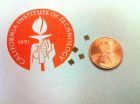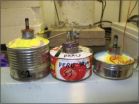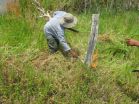Citizen science more than a century later: Ordinary people go online to track Gulf oil spill
2012-12-11
(Press-News.org) WASHINGTON—In the summer of 1854 a doctor named John Snow tracked London's deadly outbreak of cholera to contaminated water coming from a public well—the now famous Broad Street pump. But Snow's observations had to wend their way through the annals of science and took years to make an impact on the public health. Now, more than a century later, ordinary people can go online and report observations about public health problems and disasters in real time.
In a just-published study a researcher at the George Washington University School of Public Health and Health Services (SPHHS) reports on this new form of "citizen science," concluding that it can help modern-day public health officials assess health and environmental threats, such as those posed by the 2010 Gulf oil disaster. The researcher studied reports to an online Oil Spill Map and discovered that citizen science can red-flag potential hazards quickly and offers very specific local information that often fails to make it into official scientific reports.
"Thousands of people logged onto the Spill Map in the days and months following the Gulf oil spill and reported smoke, tainted seafood, foul odors linked to the oil dispersant and other problems as they were occurring on the front lines," said the author of the study Sabrina McCormick, PhD, associate professor of environmental health at SPHHS. "This reporting by ordinary people promises to be a powerful new way of conducting research and helping officials respond appropriately to disasters." McCormick published the study online December 10, 2012 in the scientific journal Ecology and Society.
The study looks back at the disaster that unfolded in the spring of 2010 when an oil rig in the Gulf of Mexico exploded and spilled nearly five million barrels of oil into the water before it was capped. The company in charge of the clean-up operation then used more than 2.1 million gallons of a chemical dispersant in order to clean up the spill. Since that time, clean-up workers, fishermen and local residents have sought medical attention for the kinds of symptoms that can arise from exposure to crude oil or chemicals in the dispersant, McCormick said.
Official reports of the disaster typically have reported few health risks but have not collected the comprehensive evidence that is needed to fully understand the consequences of the oil spill, McCormick said. She undertook the study to investigate whether a Spill Map created by the Louisiana Bucket Brigade (LABB) and other environmental justice groups would help fill in that gap. The Spill Map includes data from citizen science organizations as well as individuals who texted in reports or went online and noted problems as they occurred.
In this study, McCormick reviewed more than 2,600 online reports and conducted in-person interviews with people in the fishing industry, those working to clean up the oil and residents of Louisiana five months after the spill and again in September 2011. She found that the Spill Map helped capture reports of spill impacts, such as oil in the water, dying wildlife or health problems in real time, and included information from isolated parts of the Louisiana Bayou--places that are often not central to the official studies conducted by the U.S. Environmental Protection Agency and others.
For example, LABB gave citizens special buckets to collect air samples even in very remote areas. The data from those air samples got logged onto the Spill Map and could be added in with eyewitness accounts of oil slicked water and crucial health and environmental information. In contrast, the U.S Environmental Protection Agency also collected air samples but did so mostly in highly populated regions and thus did not monitor pollution in some of the tiny fishing villages along the Coastline, McCormick said.
In addition, the Spill Map quickly gave an account of the health problems people were experiencing as the disaster unfolded. McCormick said that people in the region texted or logged onto the map and gave accounts of rashes, respiratory problems, headaches and other problems they believed were linked to exposure to the oil or the dispersant.
Citizen science does not take the place of the traditional studies, in which trained scientists gather data and then quantify the human health or environmental consequences, McCormick says. Still, she says that the data gathered by many people on the front lines can offer important minute-to-minute information that officials can use to protect human health and the environment from an ongoing disaster.
INFORMATION:
About the George Washington University School of Public Health and Health Services:
Established in July 1997, the School of Public Health and Health Services brought together three longstanding university programs in the schools of medicine, business, and education and is now the only school of public health in the nation's capital. Today, more than 1,100 students from nearly every U.S. state and more than 40 nations pursue undergraduate, graduate, and doctoral-level degrees in public health. http://sphhs.gwu.edu/
END
ELSE PRESS RELEASES FROM THIS DATE:
2012-12-11
A medication being tested to help smokers kick the habit also may help avoid the weight gain that is common after quitting but only in women, according to a study published in the December issue of Biological Psychiatry. This is the first medication shown to reduce weight gain for up to one year in women smokers who quit.
Naltrexone — an opioid blocker that can dampen the desire for alcohol, heroin and nicotine, as well as the pleasures of eating — helped men quit smoking. It improved their quit rates after three months of treatment in a large controlled trial, from 17 ...
2012-12-11
PASADENA, Calif.—A secret agent is racing against time. He knows a bomb is nearby. He rounds a corner, spots a pile of suspicious boxes in the alleyway, and pulls out his cell phone. As he scans it over the packages, their contents appear onscreen. In the nick of time, his handy smartphone application reveals an explosive device, and the agent saves the day.
Sound far-fetched? In fact it is a real possibility, thanks to tiny inexpensive silicon microchips developed by a pair of electrical engineers at the California Institute of Technology (Caltech). The chips generate ...
2012-12-11
ATLANTA – Auditory systems differ between sexes in sparrows depending on the season, a Georgia State University neuroscientist has found. The work adds to our knowledge of how the parts of the nervous system, including that of humans, are able to change.
Megan Gall, a post-doctoral researcher with Georgia State's Neuroscience Institute, tested the peripheral auditory systems of male and female house sparrows, comparing the hearing of each gender during non-breeding seasons and breeding seasons.
Gall measured frequency selectivity – the ability to tell sounds that are ...
2012-12-11
KINGSTON, R.I.— December 10, 2012 – A University of Rhode Island researcher has discovered that the weight-loss drug orlistat, known by the brand names Xenical and Alli, inhibits a key enzyme that may lead to "severe toxicity of internal organs such as the liver and kidney." The inhibition is irreversible and can be caused by a low level of the drug.
Professor Bingfang Yan's study funded by the National Institutes of Health, also found that the drug alters efficacy of medicines, and particularly limits the effectiveness of some anti-cancer drugs.
Part of the research ...
2012-12-11
NEW YORK (Dec. 10, 2012) -- Diffuse large B-cell lymphoma (DLBCL) is the most common subtype of non-Hodgkin's lymphoma and the seventh most frequently diagnosed cancer. The most chemotherapy resistant form of DLBCL, called activated B-cell – DLBCL (ABC-DLBCL), remains a major therapeutic challenge. An international research team, led by two laboratories from Weill Cornell Medical College, has developed a new experimental drug therapy to target this aggressive form of lymphoma.
In the journal Cancer Cell, researchers report the discovery of an experimental small molecule ...
2012-12-11
URBANA – Every year farmers spend a lot of money trying to control corn rootworm larvae, which are a significant threat to maize production in the United States and, more recently, in Europe. University of Illinois researchers have been working on validating a model for estimating damage functions.
Nicholas Tinsley, a doctoral candidate in crop sciences, has refined a model developed in 2009 by researchers at the University of Wisconsin and in Brescia, Italy, to describe the relationship between root injury caused by these pests and yield loss. He used the equivalent ...
2012-12-11
DETROIT - Both nature and nurture appear to be significant factors in early antisocial behaviors of adopted children, a Wayne State University researcher believes.
Christopher Trentacosta, Ph.D., assistant professor of psychology in the College of Liberal Arts and Sciences, recently examined data from 361 linked triads (birth mother, adoptive parents, adopted child) in order to assess externalizing behavioral problems such as aggression and defiance when children were 18, 27 and 54 months of age.
The triads were part of the Early Growth and Development Study (EGDS), ...
2012-12-11
CHAMPAIGN, Ill. — The small kerosene lamps that light millions of homes in developing countries have a dark side: black carbon – fine particles of soot released into the atmosphere.
New measurements show that kerosene wick lamps release 20 times more black carbon than previously thought, say researchers at the University of Illinois and the University of California, Berkeley. The group published its findings in the journal Environmental Science and Technology.
Black carbon is a hazard for human health and the environment, affecting air quality both indoors and out. ...
2012-12-11
Young patients with an aggressive form of leukemia who are likely to relapse after chemotherapy treatment can significantly reduce those odds by receiving additional courses of chemotherapy, suggest the findings of a clinical trial led by investigators at Dana-Farber/Children's Hospital Cancer Center in Boston.
The trial leaders will present the results of the Dana-Farber Cancer Institute ALL Consortium study, which involved nearly 500 patients under age 18 with B-precursor acute lymphoblastic leukemia (B-ALL), at the annual meeting of the American Society of Hematology ...
2012-12-11
Over past decades, many areas of the forested Amazon basin have become a patchwork of farms, pastures and second-growth forest as people have moved in and cleared land--but now many are moving out, in search of economic opportunities in newly booming Amazonian cities. The resulting depopulation of rural areas, along with spreading road networks and increased drought are causing more and bigger fires to ravage vast stretches, say researchers in a new study. The study, focusing on the Peruvian Amazon, is the latest to suggest that land-use changes and other factors, including ...
LAST 30 PRESS RELEASES:
[Press-News.org] Citizen science more than a century later: Ordinary people go online to track Gulf oil spill


